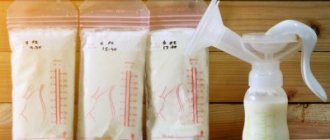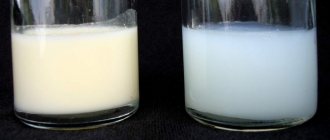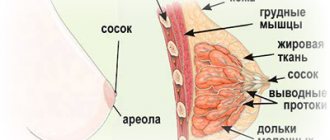Number of views: 40,278
The article was written based on the lecture “Secrets of Breastfeeding Success”, which took place as part of World Breastfeeding Week and the “Breastfeeding Outside the Home” project.
Speaker: leading lecturer of the educational project “School for Expectant Mothers”, certified breastfeeding consultant and happy mother of three children Inna Shabelnikova.
The general partner of the project was the Philips Avent brand of products for mothers and babies. In addition to breast pumps and bottles, the Philips Avent line includes a range of convenient accessories that will help breastfeeding mothers feel better and enjoy breastfeeding.
There is not enough milk in the breast - the baby does not get enough. Such thoughts often visit young mothers. The baby cannot tell whether he has enough nutrition, so the mother worries. According to statistics, most mothers who stop breastfeeding earlier than they intended to do so precisely because of the idea that their child does not have enough breastfeeding. At the same time, it is not difficult to determine whether the baby has enough food.
Where does the expression “breast milk burns out” come from?
Mothers mentally prepare for painful sensations during this period, wait for the temperature to rise and count how much breast milk burns out. However, if we consider this issue from a physiological point of view, it becomes clear that the term “burnout” has nothing to do with the curtailment of lactation.
From literature
If you turn to S.I. Ozhegov’s dictionary, you can find the following interpretations of the term “burn out”:
- deteriorate from prolonged burning or strong heat;
- dry out from the heat, collapse from overheating;
- burn, rot.
Nothing like this happens with human milk. In fact, it does not burn and is not exposed to heat or high temperatures. But these are exactly the sensations that women experience when they resort to traumatic methods of ending lactation: they bandage the breasts, abruptly stop breastfeeding.
From the history
However, there are other versions of the appearance of this phrase. There is information that in medieval Rus', when a mother finished feeding her child, there was a special custom. The woman expressed a few drops of milk onto a very hot stove or fire.
The liquid quickly turned into steam, and this was seen as a sign of the rapid and painless disappearance of milk. For modern mothers, this ritual is no longer relevant, but questions about how breast milk burns out and what the symptoms may be remain.
From erroneous conclusions
Often, after an acute respiratory infection, women notice that there is less milk in their breasts. And the chest itself became limp and seemed empty. To make sure that there is still milk left, women begin to express. And they notice with disappointment that they only manage to get a few drops. This gives rise to the conclusion that the milk has “disappeared.”
Remembering their condition during illness (fever, heat, aches and pain in the chest), nursing mothers associate the disappearance of milk solely with an abnormal temperature. “The whole body was burning with fire, and along with it the milk “burned out”,” mothers who find themselves in a similar situation mistakenly draw such conclusions.
The formulation “the milk has burned out” is outdated and has nothing to do with the processes actually occurring in the female body. Typically, women use it when they are talking about the end of breastfeeding and a decrease in milk production. However, this phrase is not related to lactation and is incorrect. The process of decreasing the amount of breast milk is correctly called “extinction of lactation.”
Video on the topic What to do if a nursing mother’s milk disappears
Why does milk disappear?
A decrease in breast milk supply may be due to factors such as:
- Late breastfeeding after childbirth - milk in the breast begins to be produced on the third day, but it is necessary to put the baby to the breast in the first hours of his life, even if it seems that the breast is empty. At this time, colostrum appears in the breast, which the baby also needs, plus breast stimulation occurs, promoting subsequent milk production.
- Pre-breastfeeding - the baby can be fed formula in the maternity hospital. The baby is full, does not want to suck, and does not stimulate the breast.
- Ineffective sucking - If your baby was born weak, he may simply not be able to suck. Also, the cause of ineffective sucking may be a weakened sucking reflex or a specific structure of the oral cavity.
- Incorrect position of the baby at the breast is the most common cause. We will write below about how to apply it correctly.
- Feeding according to a schedule - feeding strictly according to the clock does not take into account the individual characteristics of mother and baby. As a result, the breasts are not stimulated enough, little milk appears, the baby screams, and the mother cries. As a result, many people have a schedule, but their own, individual one.
- The child does NOT release the nipple on his own - limiting the duration of sucking. Some children eat quickly, others eat slowly. There are also those who fall asleep for a short time during feeding; the 20 minutes allotted by their mother is definitely not enough for them. Each child has unique characteristics and does not have to conform to the descriptions in the literature.
- Supplementation - it is not recommended to give water to a breastfeeding baby up to 6 months old; read more about this here.
- Pacifiers, pacifiers - babies have an innate sucking reflex; sucking movements stimulate lactation. If the baby sucks on something else, he may refuse the breast and the milk will gradually decrease. Nipple confusion may occur after bottle feeding. Often babies do not want to breastfeed, because milk flows easily from the bottle and there is no need to make an effort.
- Lack of family support - a woman's milk production is closely related to her emotional state. If she feels the support of her family at home, she is calm and relaxed, then there will be no problems with milk. If she is constantly told “you don’t have enough milk,” the chances of continuing breastfeeding are reduced.
Features of fading lactation
To ensure there is always enough milk, the baby must nurse frequently. The ideal situation is when the baby is fed on demand for the first three months. If this is not possible, the mother needs to express herself.
When expressing and sucking, the receptors on the nipple and areola receive active stimulation. This starts the process of forming a new secretion. An important hormone appears in the mother’s body - prolactin. The higher its concentration, the more milk will arrive for the next feeding. And vice versa.
Why is this happening?
To maintain sufficient levels of prolactin during the day, after three months it is optimal to feed baby (or express) eight to 12 times a day. The less often this happens, the less stimulation the breast receives. The level of prolactin in the blood decreases. And the sooner it becomes noticeable that there is not enough nutrition for the baby.
There is another situation when there may be less milk. For various reasons, the baby cannot always latch onto the breast correctly. Sometimes this causes sucking to become less effective. Because of this, some of the milk is retained in the alveoli and ducts. In a full breast, the production of a new secretion takes longer. The body receives a signal that the baby needs less nutrition. This means that the activity of the gland needs to be reduced. The same thing happens with ineffective pumping.
There are two interrelated reasons for the decline of lactation - insufficiently frequent breast stimulation and ineffective milk removal.
When it happens
From a physiological point of view, the main sign of the end of natural feeding is the gradual disappearance of milk. On average, its production stops within two to three weeks. The extinction of lactation is spoken of in the context of the following situations.
- When intentionally weaning a child from the breast. Mom can decide to wean the baby at any age. To do this, she deliberately limits the number of applications, bringing them to zero. The process can go smoothly or abruptly, but the mechanism of action will be the same. In the first case, the number of feedings decreases gradually. This is a physiological method that is safe and comfortable for the mother and her child. With abrupt weaning, feedings stop suddenly. This option is fraught with engorgement, lactostasis and mastitis. And it won’t be easy for the baby to part with such an important part of his life so abruptly.
- If applied incorrectly. Some mothers immediately find convenient options for attaching their newborn to the breast so that he sucks effectively. Others require a little more time and effort. In any case, improper attachment makes itself felt not only by a decrease in lactation, but also often by pain, cracked nipples, and congestion. All this significantly affects breastfeeding.
- With rare emptying of the mammary gland. Forced separation from the baby or an accidental long break in feeding can not only reduce the formation of new milk, but also cause stagnation of the secretion (lactostasis). In such cases, if the mother plans to continue breastfeeding, lactation must be maintained by pumping.
How it happens
When a mother allows her baby to breast less often, excess milk is absorbed back into the blood. This continues until it disappears completely. Part of the glandular tissue seems to “fall asleep.” The other is absorbed by the mother's body. This is called breast involution.
The bust returns to its “pre-pregnancy” state. This takes several months from the last feeding or pumping. When these processes resume, the glandular tissue is activated again.
How does mom feel?
When milk decreases, mothers notice that their breasts have become softer. It doesn't fill up as much as before. When expressing, the liquid no longer shoots out in active jets. Only a few drops of milk may be released from the breast. The bust decreases in size and approaches its previous shape.
Lactostasis
This pathological condition is accompanied by swelling and a feeling of heaviness that appears in the woman’s mammary glands. Lactostasis occurs as a result of stagnation of breast milk. This condition may be accompanied by an increase in body temperature, as well as fever, and the appearance of redness in the mammary glands.
To alleviate her condition, a woman needs to take a warm shower and drink hot tea. This will improve milk flow. Expressing will help relieve pain. After which you need to attach the baby to the sore breast.
Possible complications
However, the extinction of lactation is not always gentle and painless. If a woman suddenly stops feeding or pumping, she risks facing unpleasant consequences: lactostasis and mastitis. They appear as a result of stagnation of secretion in one or more milk lobules. The symptoms may be similar, but there are also significant differences.
Often women mistake lactostasis and mastitis for manifestations of acute respiratory infections. After all, all these conditions can be accompanied by fever. But redness, tightness and pain in the chest may not always be present. And not every woman is able to clearly identify them.
Video on the topic Lactostasis in a nursing mother - symptoms and treatment
Lactostasis
The chest becomes very full, swells, and heaviness appears in it. Pain sensations develop in the area of stagnation. Sometimes they resemble pain like a bruise. Any touch to the chest brings discomfort. Sometimes the lump can be felt with your hands. In the stagnation zone, the skin turns red, but this does not always happen. Some mothers experience a fever and notice an increase in temperature. What should mom do in this case?
- Take a shower. And drink warm tea. This will improve milk flow.
- Express milk from the sore breast. Stop when it stops flowing freely. There should be no pain when expressing.
- Attach the baby to the breast. To the one in which stagnation has formed. It is better to do this at night or during the day.
- Repeat the procedure. If necessary, repeat the above steps after 12 hours.
Video on the topic Children's doctor will talk about mastitis in a nursing mother
Mastitis
Mastitis is an inflammatory process that is often a complication of lactostasis. It is characterized by a prolonged increase in temperature (more than two days), pain in the affected part of the chest, and poor health. What should a mother do?
- Do an ultrasound. If the elevated temperature lasts more than two days, urgently do an ultrasound of the sore breast.
- Discuss the results with your doctor. You should contact a mammologist or surgeon.
- Decide on treatment. The doctor will determine whether emptying your breasts effectively will be enough or if additional medication may be needed.
- Remove stale milk. For this, the same scheme is used as for lactostasis: shower and tea - pumping - application.
Prevention of lactostasis and mastitis is effective and regular emptying of the breast. This means that a woman should not suddenly stop breastfeeding, since milk cannot disappear in a matter of hours. (Usually its production stops within two to three weeks). But such a solution can result in additional difficulties.
How to properly end lactation?
To make the weaning process smooth and comfortable for both parties, you should follow some recommendations:
- do not abruptly wean your child off from feeding - many mothers listen to long-standing advice and leave their children for several days so that they wean themselves off the breast. But this is a huge double stress and today neither pediatricians nor breastfeeding specialists recommend doing this;
- the optimal age of a child for completing lactation is 1.5-2.5 g, since at this age the baby already understands a lot, he has completely mastered complementary feeding, and his dependence on the breast is rather psychological in nature;
- Over the course of a month, it is worth gradually moving away from daytime feedings, especially if the child does it out of boredom;
- to reduce milk production, you should consume less high-calorie fatty foods and do not drink a lot of liquid;
- you can also increase your physical activity - engage in active sports or at least do exercises regularly;
- To suppress milk production, you can drink herbal decoctions of mint or sage.
It is not recommended to bandage the breasts, as this can lead to the development of purulent mastitis and infection of the internal tissues of the mammary gland.
Natural methods for ending breastfeeding
The end of breastfeeding naturally occurs when the baby has grown enough (1.5 -2.5 g) and mother’s milk is no longer the only source of nutrition and energy for him. Usually, by this time, the number of attachments is reduced and for many children, sucking at the breast is more of a mandatory ritual before bed or is always a helpful means of calming down.
By this time, the woman herself notices that the breasts are becoming softer, and they do not have the fullness that was observed in the first year of the child’s life.
It is at this time that you should gradually reduce the number of remaining attachments and explain to the baby as often as possible that he will soon stop eating mother’s milk. At this moment, a woman may encounter harsh resistance from a child who does not want to part with her breasts, but by acting smoothly and gradually, she will still be able to achieve results.
Artificial ways to stop lactation
Unlike the natural cessation of lactation and the use of herbal medicine, the use of medications to stop the presence of milk is more effective and allows you to quickly resolve this issue. Only a doctor can prescribe medications, since most of them are hormonal and have a number of side effects.
This is not the most harmless way to end breastfeeding, but there are situations when taking such drugs cannot be avoided (loss of a baby, miscarriages).
The table below shows several drugs that are most often prescribed to suppress lactation:
| Dostinex | Suppresses the production of the hormone prolactin in the body, a decrease in which in the bloodstream is noted within a few hours after taking the medicine. May cause drowsiness and low blood pressure. |
| Bromcryptnin | In addition to suppressing lactation, the drug has a sedative effect and improves heart function. After using this remedy, if necessary, lactation can be restored. Side effects may include dizziness, nausea, and weakness. |
| Cabergoline | The tablets help suppress lactation. May cause sleep problems and lightheadedness. Not prescribed if you have heart problems. |
Possible complications of breast milk burnout
The termination of breastfeeding does not always occur without consequences, painlessly and gently. This is especially common for women who are forced to stop breastfeeding abruptly. In such cases, lactostasis or mastitis can often develop. Both of these conditions have similar symptoms, but still differ from each other. With both mastitis and lactostasis, the temperature rises. In the second case, obstruction of the milk lobules occurs, which may cause difficulties with pumping.
With mastitis, difficulties also arise with the outflow of milk, but the nature of mastitis itself is infectious.
Also, women often mistake these 2 diseases for a common cold or acute respiratory infection.
Lactostasis
With lactostasis, there is a feeling of fullness in the chest, a feeling of heaviness and pain. A woman cannot feed her baby normally, as touching the breast causes discomfort. Lumps can be felt inside the mammary glands themselves, and reddening of the skin is noted in the area of stagnation. Most women experience an increase in temperature. How can a woman help herself in this situation?
Obstetricians and mammologists recommend:
- take a warm shower;
- drink warm tea with milk;
- do not refuse to latch on to the baby, since thanks to the baby’s sucking, all congestion can be removed more quickly;
- Seek help from a specialist who can help you pump out your breasts.
Mastitis
It is a complication of lactostasis, which is characterized by a prolonged increase in temperature (more than 2 days in a row), painful sensations in the chest, and poor health.
In this situation, a woman should:
- seek help from a doctor;
- undergo an ultrasound examination of the mammary glands;
- express your breasts so as not to aggravate the condition.
Prevention of mastitis is the smooth completion of breastfeeding, since if the child is abruptly weaned, the milk does not disappear quickly and, continuing to exist, can provoke the development of lactostasis and mastitis. Breast milk from the mother is the best nutrition for a child at an early age. However, sooner or later there comes a time when it is necessary to wean the baby from the breast.
In the case of smooth completion of breastfeeding, the milk does not burn out immediately, but involution (completion) occurs smoothly and most often the woman manages to avoid unpleasant sensations and symptoms and set the baby up to complete this important process.
With an abrupt end to breastfeeding, the risks of developing mastitis and lactostasis increase significantly, and the child, who is immediately deprived of access to the mother’s breast, becomes stressed. Therefore, it is preferable for both parties to end breastfeeding smoothly if possible.
Impact of colds and stress
Mothers note that they have less milk after a cold. However, in this case, a decrease in its production is most often caused not by the disease itself, but by a decrease in the number of feedings. After all, a nursing mother’s well-being does not always allow her to continue breastfeeding as usual. Therefore, as you recover, lactation can be improved.
As for stress... Excitement and excessive anxiety have a bad effect on the ability to breastfeed. Under such conditions, the hormone oxytocin is produced very reluctantly. It helps fluid drain from the chest. In the language of nursing mothers, its effect is called a “tide.”
Stress hormones block the release of oxytocin, and milk stops being produced. It may seem to a woman that it is gone forever. In reality, he simply does not have the opportunity to leave his “home”. The mother should relax, put aside her worries and put the baby to her breast. And soon she will notice that the baby is full and satisfied.
Video on the topic What to do when milk suddenly disappears?
Natural methods for ending breastfeeding
The safest way to end lactation is physiological, or the so-called feeding reduction method. First you need to reduce one feeding, then the second. As soon as the baby starts to get used to it, you need to remove another one. Between meals, you need to express milk from each breast, leaving a small amount in the mammary glands.
Then you need to eliminate night feedings. Gradually, milk arrives in smaller quantities, and the process of arrival itself occurs less and less often.
A nursing mother should avoid severe breast swelling, which can cause severe pain.
What to do to return to previous milk volumes
All that is needed to resume lactation in the previous volumes is to establish frequent feedings. However, breastfeeding can be resumed at any age of the child. Mom needs to stop worrying that the milk has disappeared forever and continue feeding her child.
It is useful to feed both breasts at one feeding if the baby is not averse to a hearty meal. To speed up the process, you can further stimulate your breasts by pumping. Depending on the situation, you can achieve the desired result in one to two weeks. Sometimes it takes a little more or less time.
Risks of drug cessation of lactation
Milk production can be stopped not only in the absence of breast stimulation. Sometimes this effect can be achieved by taking certain pills. These drugs inhibit the secretion of prolactin. However, the result of their use depends on the stage of lactation.
For the mechanism to work, the content of this hormone in the blood must be very high. This is typical for the first two months after childbirth. Later, its level is maintained through frequent applications (or pumping). But it's not that big anymore. Therefore, the use of such drugs will not bring the desired effect.
In addition, breast complications may develop. If the medication is taken against the background of low prolactin levels, milk production does not stop. Therefore, even after taking the pills, a woman may experience engorgement. With untimely or ineffective breast emptying, the risk of lactostasis, mastitis and even an abscess increases.
According to the World Health Organization, medical cessation of lactation is not recommended. This method carries too many risks for the mother's health, such as nausea, vomiting, headaches, hypotension, myocardial infarction, seizures, stroke and even death.
Video on the topic How to stop lactation without pills and breast bandaging - personal experience
Painless completion of lactation: 3 rules
Sometimes a woman wants to finish feeding her baby in a short time. This happens for various reasons. For example, a mother plans to go to work or send her child to kindergarten. Or the baby has reached the age when the mother believes that it is no longer advisable to continue breastfeeding him.
To avoid complications and discomfort in the chest, it is important to follow three simple rules for the physiological completion of lactation.
- Gradually reduce the number of feedings. The first to go is sucking while the baby is awake. Then you can limit attachments when the baby wakes up. The next stage is saying goodbye to feedings during the day and during sleep. The last thing to go is nighttime communication with the breast. This sequence is most comfortable for both the mother and her child.
- Monitor your feelings. When breastfeeding is completed, milk production is still ongoing. This process will stop after approximately two to three weeks. At this time, the mother may feel great, and then nothing needs to be done. But if there is a feeling of fullness in the breast, it is bursting from the flow of milk, it is important to immediately take measures to prevent the formation of stagnation. To do this, you need to slightly pump your chest so that the discomfort disappears.
- Gradually reduce the number of pumping sessions. The number of pumping sessions gradually decreases, and the intervals between them increase. In this way, the mother helps her body adjust to the painless decline of lactation.
Some women note that even a year or two (sometimes longer) after weaning their baby from the breast, they can still express a couple of drops of milk. If the mother does not have hormonal health problems and the discharge does not have an unpleasant odor, there is no need to worry. This is not dangerous, and this situation is normal.
As lactation fades, milk production slows down. Over time, it becomes less and less, and often women tend to believe that it has “burnt out.” However, this term is inappropriate to use in the context of breastfeeding, and it is also incorrect to calculate how many days breast milk “burns out.” Even if feedings stop suddenly, the milk may not disappear within a few hours or days. If the mother wishes, breastfeeding can be resumed at any stage of completion of lactation.
Should you see a doctor?
The optimal option for completing lactation is the physiological method, which is due to a significant reduction in the attachment of a small child to the mother's breast. Many mothers are interested in whether there is a need to contact a health care facility. If a woman wants her breast milk to burn out and lactation to stop, she must contact a medical institution for consultation with a qualified gynecologist.
The doctor will give practical advice, select the most optimal option for unnatural termination of breastfeeding, and write a prescription for purchasing the necessary medications. Contacting a specialist will allow a woman to complete breastfeeding as safely as possible, as well as avoid possible health problems.











